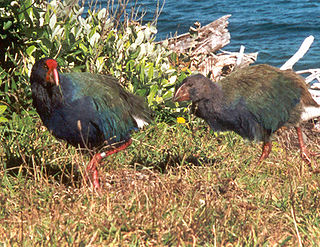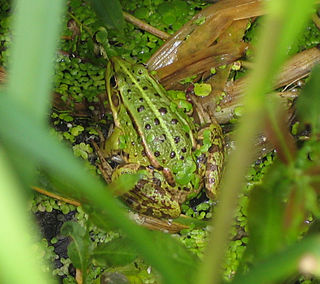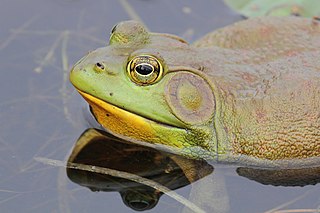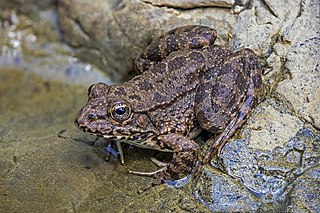
Balaenoptera is a genus of rorquals containing eight extant species. Balaenoptera comprises all but two of the extant species in its family ; the genus is currently polyphyletic, with the two aforementioned species being phylogenetically nested within it.

Ranunculus is a large genus of about 1750 species of flowering plants in the family Ranunculaceae. Members of the genus are known as buttercups, spearworts and water crowfoots.

Bombinatoridae is a family of toads found in Eurasia. Species of the family have flattened bodies and some are highly toxic.

In paleontology, a Lazarus taxon is a taxon that disappears for one or more periods from the fossil record, only to appear again later. Likewise in conservation biology and ecology, it can refer to species or populations that were thought to be extinct, and are rediscovered. The term Lazarus taxon was coined by Karl W. Flessa and David Jablonski in 1983 and was then expanded by Jablonski in 1986. Paul Wignall and Michael Benton defined Lazarus taxa as, "At times of biotic crisis many taxa go extinct, but others only temporarily disappeared from the fossil record, often for intervals measured in millions of years, before reappearing unchanged". Earlier work also supports the concept though without using the name Lazarus taxon, like work by Christopher R. C. Paul.
The Pipe Creek Sinkhole near Swayzee in Grant County, Indiana, is one of the most important paleontological sites in the interior of the eastern half of North America. It is preserved because it was buried by glacial till. Uncovered in 1996 by workers at the Pipe Creek Junior limestone quarry, the sinkhole has yielded a diverse array of fossils from the Pliocene epoch, dating back five million years. Discoveries have been made there of the remains of camelids, bears, beavers, frogs, snakes, turtles, and several previously unknown species of rodents. Two fish taxa, bullhead (Ameiurus) and sunfish (Centrarchidae), have also been found there.

Eldredgeops rana is a species of trilobite from the middle Devonian period. Their fossils are found chiefly in the northeastern United States, and southwestern Ontario.

Rana is a genus of frogs commonly known as the Holarctic true frogs, pond frogs or brown frogs. Members of this genus are found through much of Eurasia and western North America. Many other genera were formerly included here. These true frogs are usually largish species characterized by their slim waists and wrinkled skin; many have thin ridges running along their backs, but they generally lack "warts" as in typical toads. They are excellent jumpers due to their long, slender legs. The typical webbing found on their hind feet allows for easy movement through water. Coloration is mostly greens and browns above, with darker and yellowish spots.

The pool frog is a European frog in the family Ranidae. Its specific name was chosen by the Italian herpetologist Lorenzo Camerano in 1882, in order to honour his master Michele Lessona.

The Gray Fossil Site is an Early Pliocene assemblage of fossils dating between 4.5 and 4.9 million years old, located near the community of Gray in Washington County, Tennessee. The site was discovered during road construction on Tennessee State Route 75 by the Tennessee Department of Transportation in May 2000, after which local officials decided to preserve the site for research and education. The site became part of East Tennessee State University, and the Gray Fossil Site & Museum was opened on the site in 2007.

Palaeobatrachus is an extinct genus of frogs from Europe that existed from the middle Eocene to the middle Pleistocene, spanning almost 50 million years. They were obligately aquatic, and would have not spent much time on dry land. They are one of two genera and by far the largest genus in the family Palaeobatrachidae, which are considered to be members of Pipimorpha, related to the South American-African family Pipidae, which includes the African clawed frog and Surinam toad.

Lithobates, commonly known as the bullfrogs, is a genus of true frogs, of the family Ranidae. The name is derived from litho- (stone) and the Greek bates, meaning one that treads on rock, or rock climber. As presently defined, it includes many of eastern North America's most familiar aquatic frog species, including the American bullfrog, green frog, and the leopard frogs.
The Ryūkyū brown frog is a species of true frog endemic to the Ryūkyū Islands, specifically Okinawa and perhaps neighboring islands.

The Kampira Falls frog, also known as the Yaeyama harpist frog or harpist brown frog, is a species in the true frog family (Ranidae). Until recently known as Rana psaltes, it is found on Ishigaki and Iriomote in the Yaeyama Islands of Japan, as well as on Taiwan.

Andrias scheuchzeri is an extinct species of giant salamander belonging to the genus Andrias, which also contains the closely related living Asian giant salamanders. It is known from Oligocene to Pliocene aged deposits primarily from Central Europe, but possibly as far east as Western Siberia and eastern Kazakhstan.

Pelophylax is a genus of true frogs widespread in Eurasia, with a few species ranging into northern Africa. This genus was erected by Leopold Fitzinger in 1843 to accommodate the green frogs of the Old World, which he considered distinct from the brown pond frogs of Carl Linnaeus' genus Rana.

Orcinus citoniensis is an extinct species of orca identified in the Late Pliocene of Italy and the Early Pleistocene of England. It was smaller than the modern killer whale, 4 m (13 ft) versus 7 to 10 m, and had around 8 more teeth in its jaw. It may have resembled the modern killer whale in appearance, and could represent a transitional species between the modern killer whale and other dolphins. O. citoniensis could have hunted fish and squid in pods, and coexisted with other large predators of the time such as the orcinine Hemisyntrachelus and the extinct shark Otodus megalodon.
Acer palaeorufinerve is an extinct maple species in the family Sapindaceae described from series of isolated fossil samaras and leaves. The species was described from Miocene to Pliocene aged fossils found in Japan and is known from Korean fossils and Miocene sediments exposed in the state of Alaska, USA. It is one of several extinct species placed in the living section Macrantha.
Miobalaenoptera is an extinct genus of rorqual from the Late Miocene (Messinian) of Japan.
Pliolymbus is a fossil genus of grebe known from the Late Pliocene to Early Pleistocene of United States and Mexico. It is known from a single species, P. baryosteus.
Rana strausi is an extinct species of true frog from the late Pliocene discovered in Willershausen, Germany.














